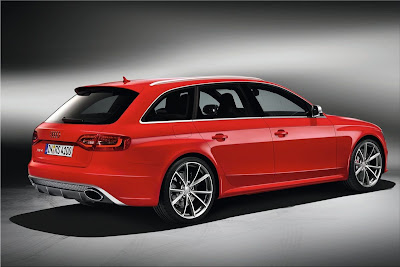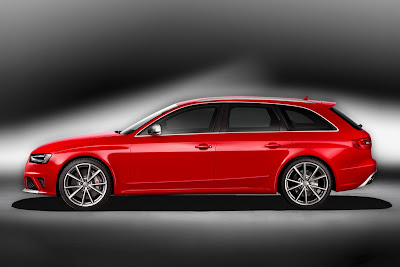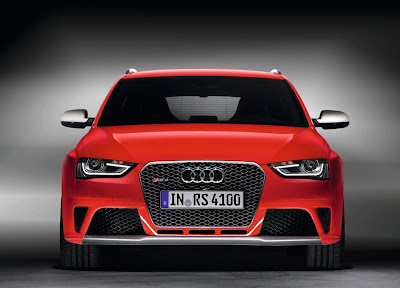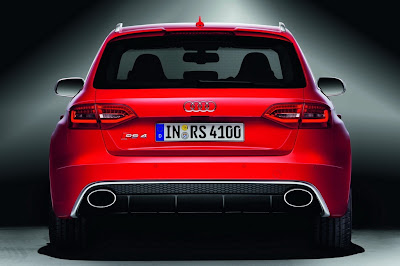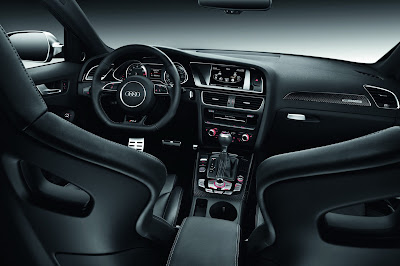First introduced 12 years ago, the Audi RS4 Avant is a modern classic. Audi now presents the third generation of the car, with a high-revving V8 FSI developing 331 kW (450 hp), a high-performance drivetrain and a diverse range of assistance and infotainment technologies. Like all RS models, the new RS4 Avant is a sports car for everyday use. It combines strong performance with unrestricted utility.
Audi RS4 Avant
The new Audi RS4 Avant is immensely powerful. Its 4.2 FSI produces 331 kW (450 hp) at 8,250 rpm, with 430 Nm (317.15 lb-ft) of torque available between 4,000 and 6,000 rpm. The normally aspirated, high-revving V8 accelerates the top-of-the-line Avant from zero to 100 km/h (62.14 mph) in 4.7 seconds on its way to a governed top speed of 250 km/h (155.34 mph). This can be increased to 280 km/h (173.98 mph) upon request. However, average fuel consumption is a mere 10.7 liters of fuel per 100 km (21.98 US mpg).
Audi RS4 Avant
With its long top gear, the standard seven-speed S tronic contributes to the good fuel economy. Launch Control manages starts with optimal traction at the push of a button. As with every Audi RS model, the engine's power flows to all four wheels via the quattro permanent all-wheel drive, here in the latest stage of development with the self-locking crown gear center differential and torque vectoring. Audi also offers the optional sport differential, which actively distributes the power between the rear wheels.
Audi RS4 Avant
The suspension of the Audi RS4 Avant is made largely of aluminum. The body is lowered by 20 millimeters (0.79 in) compared with the A4 Avant. The new electromechanical power steering is highly efficient and provides excellent road feedback.
The 19-inch, forged alloy wheels are fitted with 265/35-series tires. 20-inch wheels are available as an option. The brake system features large, internally vented discs with an innovative wave design; the front calipers each have eight pistons.
Carbon fiber-ceramic discs are available up front upon request. The electronic stabilization control (ESC) has a Sport mode and can be deactivated entirely, if necessary.
Audi RS4 Avant
Dynamic: sport suspension plus with DRC
The Audi drive select dynamic system is standard. Dynamic steering, the sport differential and the sport suspension plus with Dynamic Ride Control (DRC) are available as options. The latter is a purely hydraulic system without any lag, whose damping can be switched between the three characteristics comfort, auto and dynamic via Audi drive select.
Audi RS4 Avant
The design of the new Audi RS4 Avant also expresses its dynamic nature. The wedge-shaped headlights use xenon plus technology, and the LED daytime running lights constitute a narrow brace. The upper corners of the large single-frame grille are tapered. Sharp creases divide the engine hood, and large air inlets structure the distinctive front skirt. The rear lights feature LED technology.
Audi RS4 Avant
The elegant interior is entirely in black. Carbon inlays are standard, with aluminum, piano finish or stainless steel mesh available as options. The leather multifunction sport steering wheel is flattened at the bottom, and the head restraints are integrated into the backs of the S sport seats. Luggage capacity ranges between 490 and 1,430 liters (17.30 and 50.50 cubic feet), depending on the position of the rear seatbacks.
Audi RS4 Avant
All display and control elements in the new Audi RS4 Avant, up to and including the optional MMI navigation plus, impress with their fine finish and clear ergonomics. Audi also offers a wide selection of modern driver assistance systems and infotainment modules as options. These include the Bang & Olufsen sound system and the Bluetooth online car phone, which delivers the tailored services of Audi connect to the car.
The RS4 will arrive at dealerships in fall 2012, with prices in Germany starting at €76,600.
Engine
The strong heart of the new Audi RS4 Avant has eight cylinders. The 4.2 FSI, which displaces 4,163 cc, combines excellent pulling power with instant response and an exhilarating willingness to rev, all backed by a widely differentiated, musical sound spectrum. The V8 produces 430 Nm (317.15 lb-ft) of torque from 4,000 to 6,000 rpm and puts out 331 kW (450 hp) at 8,250 rpm. The maximum torque is 8,500 rpm. The naturally aspirated FSI has a specific power output of 79.5 kW (108.1 hp) per liter of displacement; each hp only needs to move 4.0 kilograms (8.82 lb) of weight.
The 4.2 FSI accelerates the new top model in the A4 family from zero to 100 km/h (62.14 mph) in 4.7 seconds on its way to a governed top speed of 250 km/h (155.34 mph). This can be increased to 280 km/h (173.98 mph) upon request. The eight-cylinder engine averages 10.7 liters of fuel per 100 kilometers (21.98 US mpg) - 26 percent less than the previous model.
The technologies from the Audi modular efficiency platform are behind this impressive figure. The cylinder barrels and the chain drive are characterized by minimal friction, and the oil pump is demand-controlled.
The normally aspirated V8 is also a visual experience. Its cylinder head covers are painted red, and an optional carbon inlay adorns the intake plenum. The hand-built 4.2 FSI has a classic cylinder angle of 90 degrees. The two opposing banks are offset by 18.5 millimeters.
The V8 weighs just 216 kilograms (476.2 lb). The forged crankshaft, the forged steel connecting rods and the pistons forged from a high-strength aluminum alloy are all lightweight, yet strong. The crankcase is manufactured using the low-pressure die-casting method, which ensures particular homogeneity. The aluminum-silicon alloy combines low weight with high strength. Its high silicon content makes the cylinder barrels extremely durable.
The crankcase is configured as a bedplate construction. The lower bearing bridges for the crankshaft are integrated into a common frame for maximum rigidity and optimal vibration behavior. The cast iron bearing bridges reduce the thermal expansion of the crankcase and thus keep the play at the main bearings of the crankshaft within tight limits.
As in all Audi gasoline engines, fuel is distributed to the 4.2 FSI via common rail direct injection using FSI technology. The fuel is swirled intensively in the combustion chambers, which cools the walls. This process minimizes the risk of knock - the detonation of the mixture on hot spots. It allows a very high compression ratio of 11.0:1, which increases both output and efficiency.
Breathing freely: gas exchange
The long-stroke engine (bore x lift 84.5 x 92.8 mm [3.33 x 3.65 in]) can breathe freely in and out thanks to intensive refinements to the dual-flow intake and exhaust system with the two throttle valves. Vacuum-actuated tumble flaps controlled by the engine management system are integrated into the intake ports. Under partial load, they cause the air to move with a roller-like rotation, which increases the burning rate and thus the efficiency of the combustion process.
The four camshafts, which can be adjusted hydraulically through 42 degrees of crankshaft angle, are driven by chains running on the back side of the engine. The 32 valves, which are actuated via roller cam followers, have large diameters - 33.9 millimeters (1.33 in) on the intake side and 28.0 millimeters (1.10 in) in the case of the sodium-coiled exhaust values.
The Audi developers also adhered to the principles of ultra-lightweight construction for the peripherals of the 4.2 FSI. The intake manifold is made of polymers; a pressure sensor is used to measure the loads very precisely. The V8 gets by with only a single, newly developed controller.
The pipes of the manifold and of the exhaust system, which have been optimized for low backpressure, are hydroformed from stainless steel. A flap is integrated into each of the two large tailpipes of the dual exhaust system. At higher loads and engine speeds - or at the push of a button in the Audi drive select system - they open to provide a richer sound. Audi offers an optional sport exhaust system with black tailpipe tips that also includes this switching function.
Drivetrain
The seven-speed S tronic transmission in the new Audi RS4 Avant harmonizes perfectly with the high-revving character of the 4.2 FSI and is designed for 9,000 rpm. Compared with the volume model, targeted modifications have been made to certain aspects of the dual-clutch transmission. The seventh gear is relatively long to reduce fuel consumption.
The seven-speed S tronic consists of two sub-units, whose multi-plate clutches actuate different gears. The large K1 clutch located on the outside directs the power via a solid shaft to the gear wheels for the odd-numbered gears 1, 3, 5 and 7. A hollow shaft rotates around the solid shaft. It is connected to the smaller K2 clutch, which is integrated into the inside of the K1 clutch, and which controls the gear wheels for the even-numbered gears 2, 4 and 6, as well as the reverse gear.
Both transmission sub-units are continuously active, but only one is powered at a time by the engine. For example, when the driver accelerates in third gear, the fourth gear is already engaged in the second transmission section. The shifting process takes place as the clutch changes - K1 opens and K2 closes. Shifting gears takes only a few hundredths of a second and is completed with practically no interruption of traction. It is so dynamic, fluid and smooth that it is hardly noticeable.
The driver of the new Audi RS4 Avant can use the seven-speed S tronic in a number of different ways. The fully automatic mode offers the D (Drive) and S (Sport) programs. The management system also considers the mode selected in the Audi drive select dynamics system.
If the driver changes gears manually, either via the gear selection lever or the paddles behind the steering wheel, the seven-speed S tronic switches into a particularly sporty mode. It no longer upshifts when accelerating, for example. If the dynamic Audi drive select mode is active, the transmission management system double-clutches when downshifting.
Another specialty of the seven-speed S tronic in the Audi RS4 Avant is the launch control function, which enables extremely dynamic starts. The driver needs only to press the accelerator to the floor. The system manages the engagement of the clutch so that all of the power of the 4.2 FSI is delivered to the road via the quattro permanent all-wheel drive system with perfectly controlled tire slip.
Latest evolutionary stage: the quattro powertrain
In its latest evolutionary stage, the quattro powertrain features the self-locking crown gear center differential and torque vectoring. The two crown gears rotating inside the center differential get their name from their tooth geometry.
The front crown gear acts on the output shaft to the front axle differential, the rear gear on the prop shaft to the rear axle differential. A lightweight plug construction provides the connection. The crown gears mesh with four rotatable pinion gears. They are arranged at right angles to each other and are driven by the differential's housing, i.e. by the transmission output shaft.
Under normal driving conditions, the two crown gears rotate at the same speed as the housing. Because of their special geometry, they have specifically unequal lever effects. Normally 60 percent of the engine torque goes to the rear differential and 40 percent to the front differential.
If the torques change because one axle loses grip, different speeds and axial forces occur inside the differential, and the integrated plate packages are pressed together. The resulting self-locking effect now diverts the majority of the torque to the axle with the better traction; up to 85 percent can flow to the back. If the rear axle has less traction, up to 70 percent of the torque flows to the front axle.
With this extremely broad torque distribution range, the crown-gear center differential surpasses its predecessors. Forces are redistributed without any time lag and absolutely consistently. The mechanical operating principle guarantees maximum efficiency and immediate response. Other strong points of the crown-gear differential are its compactness and low weight - at 4.8 kilograms (10.58 lb) it weighs roughly two kilograms (4.41 lb) less than the previous unit.
In the new Audi RS4 Avant, the crown-gear differential works together with an intelligent software solution in the brake management system so that torque vectoring acts on all four wheels. When cornering at speed, its control unit uses the driver's steering input and the position of the gas pedal to calculate the optimal distribution of power. If it detects that the wheels on the inside of the curve, which are under a reduced load, are about to slip, it marginally brakes these wheels - just slight application of the pads on the disks at minimal pressure is all that it takes.
Torque vectoring works smoothly and continuously. The Audi RS4 Avant remains neutral for an extremely long time at the handling limits; the slight understeer when turning into curves and when accelerating is essentially offset. The ESC stabilization control intervenes later and more gently - if it is even necessary at all.
High-tech rear differential: the sport differential
As an additional option, Audi supplements the quattro powertrain with the sport differential, which actively distributes the power between the rear wheels. When turning into or accelerating in a curve, it directs the majority of the torque to the outside wheel and pushes the Audi RS4 Avant into the curve, nipping the tendency to oversteer or understeer in the bud.
With the sport differential, a superposition gear comprising two sun gears and an internal gear is mounted on both sides of a conventional differential. It turns 10 percent faster than the drive shaft. A multi-plate clutch in an oil bath and operated by an electrohydraulic actuator provides the power connection between the shaft and the superposition gear.
When the clutch closes, it steplessly imposes the higher speed of the superposition stage on the outside wheel. The additional torque required is drawn away from the inside wheel via the differential. In this way nearly all of the torque can be directed to one wheel. The maximum difference between the wheels is 1,800 Nm (1,327.61 lb-ft).
The sport differential is just as effective when coasting and rolling as it is under load, reacting electronically in just a few hundredths of a second. Audi has developed special software for use in the Audi RS4 Avant. The controller constantly recalculates the ideal distribution of the forces for each driving situation as a function of the steering angle, yaw angle, lateral acceleration, speed and other information.
Chassis
The sports car for everyday use offers exhilarating dynamics. Its handling is uncompromisingly precise; its reactions are virtually instantaneous, and its stability guarantees maximum driving safety. The newly developed electromechanical power steering connects the driver with the road to provide sensitive, well-differentiated feedback.
Steering boost changes as a function of speed. The electric motor integrated into the steering gear consumes no energy when driving straight ahead, thus lowering fuel consumption by as much as 0.3 liters per 100 km. The steering gear is very compact thanks to the concentric arrangement of the steering rack and servo drive.
The electromechanical power steering system's ratio of 16.3:1 is sporty and direct. The low-mounted steering gear communicates the steering input to the wheels over the shortest possible distance via the track rods.
The Audi RS4 Avant has a turning circle of approximately 11.9 meters (39.04 ft). The steering works closely together with the optional assistance system Audi active lane assist. When braking on a surface that is slippery on one side, the system helps the driver by facilitating the proper corrections and inhibiting improper steering movements.
All major suspension components are made of aluminum, which greatly reduces the unsprung masses. The five-link front suspension processes the longitudinal and lateral forces separately. The aluminum frame to which it is linked makes the front end extremely rigid. The springs and dampers of the track-controlled trapezoidal link rear suspension are separated to improve response behavior. The links are mounted on a steel subframe on elastic bearings.
Decidedly taut: the setup
The Audi engineers have given the new RS4 Avant a strictly dynamic setup. Stiff bearings provide for sporty elastokinematics, and the stabilizer bars are thicker than in the volume A4. The shock absorbers are stiffer, and the body has been lowered 20 millimeters (0.79 in). Audi also offers the sport suspension plus with Dynamic Ride Control (DRC) as an option. It reduces all body movements purely mechanically and thus without any lag, and is compact and lightweight.
The principle behind the DRC is impressively simple. The diagonally opposed pairs of shock absorbers are linked by hydraulic lines and a central valve. When cornering at speed, the valves regulate the oil flow in the shock absorber of the deflected outside front wheel almost immediately. They increase the support provided and reduce lateral tilt. The system is combined with variable damper control, which can be switched between three stages using the standard Audi drive select dynamics system.
In addition to the sport suspension plus and the sport differential, both of which are optional, Audi drive select also incorporates the electromechanical power steering, the seven-speed S tronic, the engine's throttle valves and the sound flap in the exhaust system.
The driver can vary the function of these systems between the modes comfort, auto and dynamic. And if the car is equipped with an MMI navigation system, there is also a fourth mode which can be configured within certain limits by the driver.
Another optional component of Audi drive select is dynamic steering, whose characteristics have been specially tuned in the Audi RS4 Avant. The key component is a high-tech superposition gear in the steering column. It steplessly varies the steering ratio as a function of speed, from very direct when maneuvering to indirect on the highway. At the cornering limit, the dynamic steering countersteers with minimal pulses, making the handling even more dynamic, fluid and safe. It prevents the car from pulling when braking on a surface that is slippery on one side.
The Audi RS4 Avant comes standard with ten-spoke wheels made of machine-polished forged aluminum. The 9J x 19 wheels are fitted with 265/35-series tires. Audi offers optional 20-inch wheels in three variants with 265/30-series tires, with two featuring a machine-polished, titanium-look finish. Winter wheels featuring the same dimensions are available. All tires have been optimized for rolling resistance without compromising handling or braking.
Powerful and lightweight: the brakes
Large wave-design discs are mounted behind the large wheels. Discs measuring 365 millimeters (14.37 in) in diameter and 34 millimeters (1.34 in) thick are mounted on the front axle; the rear axle features discs measuring 324 x 22 millimeters (12.76 x 0.87 in). The friction rings are internally vented and perforated. Their new wave-like outer contour reduces the overall weight of the brake system by roughly 2.5 kilograms (5.51 lb). Stainless steel pins connect the steel friction rings to the aluminum brake caps. This concept borrowed from racing reduces tensions, quickly dissipates the heat and prevents the transmission of temperature peaks.
The monoblock calipers painted high-gloss black and bearing RS logos are also made of aluminum. The front calipers each have eight pistons; single-piston floating calipers are mounted on the rear axle.
For the front axle, Audi offers the option of 380 millimeter (14.96 in) perforated carbon fiber ceramic discs and six-piston calipers in Anthracite Gray. The base material is silicon carbide, a material with a diamond-like crystal structure in which high-strength carbon fibers are embedded.
The geometry of the cooling channels quickly dissipates the heat. Titanium bolts connect the friction rings to the forged aluminum caps. The ceramic discs are practically fade-free, extremely robust, powerful and durable. Altogether they weigh 4.5 kilograms (9.92 lb) less than the steel discs despite their larger size.
The ESC stabilization control has been specially configured for the dynamic profile of the new Audi RS4 Avant. With the touch of a button, the driver can select the Sport mode that deactivates the engine interventions and thus permits spectacular but safe drifts when accelerating. The ESC can also be deactivated entirely for particularly dynamic driving. A subfunction of the system is the optional Audi hold assist. It makes it easier to start off on grades by maintaining the pressure in the system after the brake pedal is released.
Exterior design
The high-performance character of the Audi RS4 Avant is clearly evident at first glance. The elegant exterior design is distinctively accentuated by sharp details that change the exterior dimensions compared with the volume model. The new top model in the model series is 4,719 millimeters (15.48 ft) long, 20 millimeters (0.79 in) longer than the A4 Avant. It has a width of 1,850 millimeters (6.07 ft), which is 24 millimeters (0.94 in) wider than the model on which it is based, yet its height of 1,416 millimeters (4.65 ft) is 20 millimeters (0.79 in) lower.
The hexagonal single-frame grille is set in a frame with a matt aluminum-look finish; its honeycomb insert is finished in high-gloss anthracite and adorned with an RS4 badge. LED daytime running lights encircle the xenon plus units like a clasp in the wedge-shaped headlights with a wavy bottom edge. The air flows through large air inlets broken up by angled struts and covered with honeycomb grilles. They are integrated into a boldly contoured bumper that tapers into a splitter edge. The low center air inlet is divided into three small openings.
The side view is dominated by the chiseled side sill caps and flared wheel wells. The flared side elements with the sharp horizontal upper edges are a small tribute to that all-wheel drive pioneer from 1980, the Audi quattro. The side mirror housings and trim strips have a matt aluminum-look finish, and an extended roof spoiler with a recessed center segment increases the downforce on the rear axle.
Catching the eye at the intensively sculpted rear end of the car are the RS4 badge and the prominent bumper. The two large, elliptical tailpipe tips of the dual exhaust system are integrated into the diffuser, which extends far upward. In the upper section of the diffuser is a honeycomb insert. If the optional matt aluminum styling package is selected, an aluminum-look contour above the insert separates the diffuser from the body. The standard LED rear lights radiate elegant light patterns.
A choice of eight colors is offered: solid Ibis White, the metallic paint finish Suzuka Gray, the pearl effect colors Daytona Gray, Misano Red, Phantom Black and Sepang Blue, and the specially pigmented crystal effect colors Panther Black and Prism Silver. Audi exclusive customized paint finishes are also available. Other elegant alternatives are the styling packages in black or matt aluminum as well as the carbon engine compartment cover.
The body of the high-performance Avant boasts high rigidity and crash safety combined with low weight. A strut brace is integrated into the front section of the car. The extensively clad underbody includes air vents for the seven-speed S tronic and the front brakes. Thanks to its advanced aerodynamics, the Audi RS4 Avant generates downforce at high speed to further enhance stability. The cD value is 0.34; the front surface area measures 2.18 m² (23.47 sq ft).
Interior
The spacious interior is sporty and elegant; the fit and finish of uncompromising quality. The controls, another classic Audi strength, are intuitive to the last detail. The terminal for the optional MMI navigation plus, for example, has five hard keys for the menu functions, and the volume control now includes a skip function for moving to the next song.
The interior is entirely in black. The one exception is the headlining, which is optionally available in lunar silver. Carbon inlays are standard, with matt brushed aluminum, 3D-look Aluminum Race, black piano finish or a light stainless steel mesh available as options. quattro GmbH also offers a selection of elegant wood veneers as part of the Audi exclusive range for further customization.
The S sport seats are standard in the dynamic top model. They feature large side bolsters on the backrest and the extendable seat cushion, integrated head restraints, seat heating and power adjustment, including a four-way power lumbar support. The S sport seats are covered with a combination of black leather and Alcantara.
Audi offers Fine Nappa leather in black or lunar silver accentuated with rock gray piping as an option. Other options include bucket seats or luxurious, climate-controlled comfort seats with a ventilation function. The Audi exclusive range includes high-grade leather packages, including bucket seats covered in diamond-quilted Valcona leather.
A world of wonders: behind the steering wheel
The leather multifunction sport steering wheel has a deeply sculpted rim covered in perforated leather. It is flattened at the bottom, and the shift paddles are in aluminum look. The control buttons and rollers provide fast access to the driver information system with its color display. It includes a special RS menu with a lap timer and an oil temperature gauge. When the car is started, both it and the MMI screen display an RS welcome logo, and the needles of the speedometer and tachometer briefly run up before returning to zero.
The bezels of the instrument cluster and the center console shine with a piano finish, and the design of the selector knob of the seven-speed S tronic is unique to the RS. The door openers taper down to separate, narrow bars - a classic RS detail.
The pedals, the footrest, the air vents, the MMI buttons and many other controls feature a gleaming aluminum-look finish. Chrome clasps encircle the power window buttons and the seat adjustment switches. Aluminum inlays adorn the door sill trims, which like the head restraints, the steering wheel, the instrument cluster and the gear selector lever are accentuated with RS4 logos.
The Audi RS4 Avant is a sports car with very practical talents for everyday use. Depending on the position of the rear seatbacks, its luggage compartment has a capacity of 490 to 1,430 liters (17.30 to 50.50 cubic feet), and the roof rails are standard. Optional equipment includes a rail system with load-securing set and a power rear hatch.
Equipment and trim
The new Audi RS4 Avant will roll into dealerships in fall 2012, with a base price in Germany of €76,600. Standard equipment includes the parking system plus, automatic air conditioning, the concert CD radio with eight speakers, folding rear seats including a load-through hatch, and an extensive package of safety features and restraint systems. This includes six airbags, the integral Audi head restraint system and Isofix anchor points for child safety seats in the rear.
There is also a wide range of comfort and convenience options. These include the convenience key, adaptive light, high-beam assistant, panoramic tilting sunroof, three-zone deluxe automatic air conditioning, tinted rear windows, shades for the side rear windows and a storage package.
Audi offers all of the assistance systems from the A4 model series for the new RS4 Avant. The driver information system with rest recommendation function (standard) detects when the driver is getting tired. Adaptive cruise control keeps the car at a set distance from the car ahead.
At speeds below 30 km/h (18.64 mph), it initiates a full brake application in the event of an impending collision. Audi side assist uses rearward-facing radar sensors to make changing lanes safer, Audi lane assist uses slight steering interventions to help the driver to stay in the lane and the parking system plus with reversing camera facilitates maneuvering.
A wide range of multimedia components is also available. The top-of-the-line system is MMI navigation plus, a control and navigation center with a large hard drive, a DVD drive, a 7-inch color monitor with 3D graphics and whole-word destination input. Hi-fi fans can order the Bang & Olufsen Sound System, which sends 505 watts of power to 14 speakers.
The ideal complement to MMI navigation plus is the Bluetooth online car phone, which uses a UMTS module to connect the Audi RS4 Avant to the Internet. Passengers can surf the web freely with their mobile devices via the integrated WLAN hotspot. For the driver, the system delivers tailored online services from Audi connect to the car - from Audi online traffic information to navigation with images from Google Earth to the new web radio Audi music stream.
Articles Source : NetCarShow

